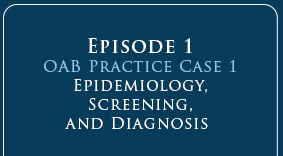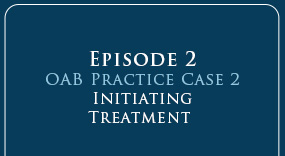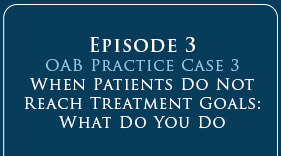| Program Overview Overactive bladder (OAB) is a chronic, debilitating condition that impacts approximately 34 million Americans. Though OAB is a common condition, it is estimated that less than 30% of patients receive treatment, likely attributed to the reluctance of patients to talk to their healthcare providers about the condition. Left untreated, OAB can significantly impact a patient’s quality of life, including physical, psychological, social, domestic, occupational, and sexual aspects. The economic cost of OAB is also staggering, estimated at nearly $66 billion annually in the US. To improve patient quality of care and satisfaction, clinicians should take a proactive approach to screen patients and provide education regarding OAB. This should include information about normal lower urinary tract function, what is known about OAB, the benefits vs. risks/burdens of the available treatment options, and the importance of adherence to treatment. It is also essential for clinicians to educate their patients on expected outcomes from current therapeutic options and develop realistic patient-centered goals for treatment. As the science relevant to OAB evolves and improves, and the literature continually expands, PCPs must stay up-to-date on new treatment strategies and therapeutic options. With the implementation of the Affordable Care Act, many who were previously uninsured will now pursue medical assistance to manage long-standing signs and symptoms. Often-times, the first provider-patient contact will be with a PCP, who will be in an ideal position to screen, diagnose and treat patients with OAB. Target Audience This educational activity is designed as a comprehensive approach to address the practice needs of primary care providers, including family physicians, physician assistants, nurse practitioners, and allied healthcare professionals, who are at the forefront of caring for adult patients who may be suffering from OAB. This program targets healthcare providers who are involved in the screening and management of patients experiencing symptoms of OAB. Learning Objectives Healthcare professionals participating in this educational activity will be able at its conclusion to:
|
Educational Format
This webcast on demand is based on the CME Satellite Symposium presented during the AAFP Scientific Assembly and is divided into three episodes. Each episode opens with an interactive patient case scenario that reflects the challenges and decision-making process that occurs regularly in clinical practice when caring for patients with OAB. Please Note: If you have received credit for attending the live symposium by the same name, you are not eligible to apply for credit for this online version.
Faculty
|
||||||||||||||||||||||
Physicians This activity has been planned and implemented in accordance with the accreditation requirements and policies of the Accreditation Council for Continuing Medical Education through the joint providership of the Center for Independent Healthcare Education and Vemco MedEd, LLC. Center for Independent Healthcare Education (Center) is accredited by the Accreditation Council for Continuing Medical Education to provide continuing medical education for physicians. Physician Assistants Nurse Practitioners For questions regarding accreditation, please contact info@jointsponsor.com
Method of Participation and Instruction for Credit
DISCLOSURE OF CONFLICTS ON INTEREST
PLANNING COMMITTEE MEMBERS |
DISCLOSURE OF FINANCIAL INTEREST SUMMARY Mickey Karram, MD (faculty/planner) has relevant financial relationships with commercial interests: Scott A. MacDiarmid, MD (faculty/planner) has relevant financial relationships with commercial interests: Patrick Shenot, MD (faculty/planner) has relevant financial relationships with commercial interests: No (other) speakers, authors, planners or content reviewers have any relevant financial relationships to disclose. No (other) speakers or authors will discuss off-label use of a product. Content review confirmed that the content was developed in a fair, balanced manner free from commercial bias. Disclosure of a relationship is not intended to suggest or condone commercial bias in any presentation, but it is made to provide participants with information that might be of potential importance to their evaluation of a presentation.
Fee Hardware/Software Requirements Software/Hardware Connection Speed System Check Copyright Statement Privacy Policy http://www.vemcomeded.com/privacy.aspJoint Providership This activity is jointly provided by Center for Independent Healthcare Education and Vemco MedEd. Commercial Support |
START ACTIVITY |






